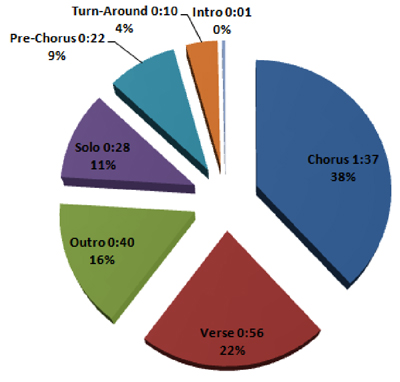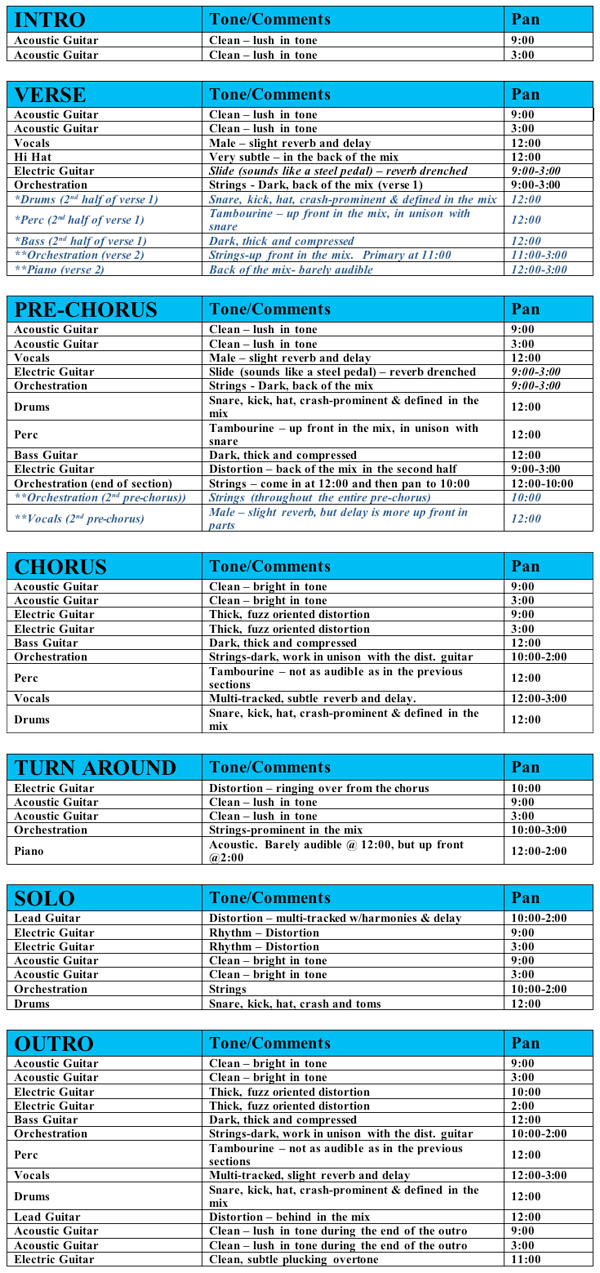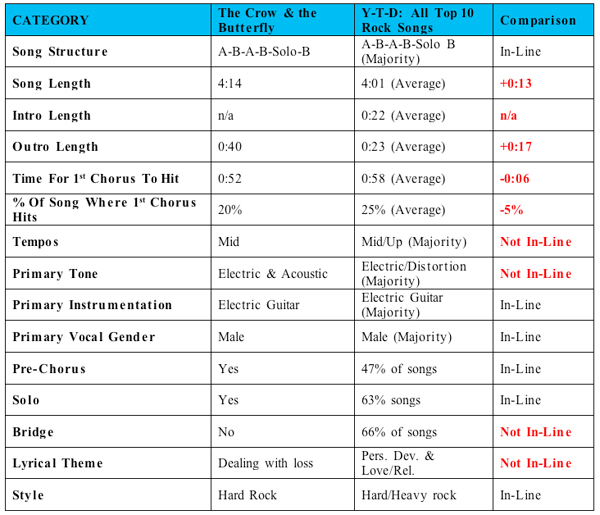

Skip to:
Audio/Video
General Information
At a Glance
Structural Analysis
Sectional Analysis
Waveform
Primary Instrumentation, Tone & Mix
Benchmark Analysis
Overall Assessment
Hit Factor Assessment
Conclusion
Why it’s a Hit
Take Aways
Audio/Video Back to Top
General Information Back to Top
Artist: Shinedown
Song/Album: The Crow and the Butterfly/The Sound Of Madness
Songwriter(s): Brent Smith
Chart Week: August 14, 2010
Chart Position: # 1 Billboard Rock Song
Genre: Rock
At a Glance Back to Top
Length: 4:14
Structure: A-B-A-B-Solo-B
Tempo: Mid
First Chorus Hits: 0:52 (20% into the song)
Intro Length: n/a
Outro Length: 0:40
Primary Instrumentation Type: Electric/Acoustic
Mood: Dramatic
Lyrical Theme: Dealing with the loss of a loved one
Primary Lyrical P.O.V: 1st person
Structural Analysis Back to Top
At-a-Glance


Section Length (Length of each individual section within the song)


What’s interesting here is that the majority of sections are not uniform in nature with one another (i.e. choruses, verses and pre-choruses are not consistent in length throughout the song). The vast majority of hit Rock songs have sections that equal each other in length, or are at least a divisible percentage (i.e. a double chorus).
Now, let’s look at the structure another way. You can take the first part of the 1st verse (the acoustic section) and consider it as an intro (instead of the quick 0:01 guitar line). Doing that, the second part of the 1st verse (where the band kicks in), is actually 0:14 in length, the same as verse 2. The phrasing is actually similar in nature as well (more so than the acoustic portion of the 1st verse). So – now we have a proper intro section and two verses that are identical in length and feel. It really all comes down to how you want to look at the song – it’s all subjective.
Structure Timeline (Shows when each section hits within the timeline of the song)


Total Section Analysis (Total time consumed by each section and its percentage of the total song)


Looking at each section totaled as a whole, it’s obvious that the emphasis of the song is on that explosive, soaring chorus, comprising 38% of the total song. Two other sections that we should take note of are the intro and the outro. The intro is interesting in the sense that there basically isn’t one (considering that you don’t count the first part of verse one as an intro, and count the first 0:01 guitar line as a quick intro). The vast majority of hit Rock songs all have some sort of more substantial intro, and this song is unique in the fact that it doesn’t. The outro is also interesting in the sense that it is quite long in comparison to most other hit rock songs at 0:40 in length (comprising 16% of the total song).
Momentum/Intensity Factor (Evaluation of the intensity of each section within the song timeline on a scale of 1 – 10, 10 being the most intense)


This song does a great job of building and releasing momentum/intensity, and does a fantastic job in maximizing the impact of the focal point of the song, the explosive chorus.
We start out mellow, with the vocal and acoustic guitar during the first half of the first verse, and then building up the intensity with the entire band kicking in during the second half. The momentum is carried through the pre-chorus, before kicking into the explosive, soaring chorus. It’s then brought back down during the turn-around, and the build repeats into the second chorus. The solo brings it down just a tad (specifically with the way the section is structured), and then we kick it back up again into the third chorus through the first half of the outro. We’re then brought back down again to the level from the intro with the acoustic guitar finale.
Sectional Analysis Back to Top
Intro: n/a
As discussed in the section length part of the report, the current 0:01 guitar line intro is relatively insignificant and barely warrants the tag “intro.” We can consider the first (solo acoustic) part of the verse to be an intro, but for purposes of this report, we’re not going to look at it that way. It’s still really a verse in nature.
Verse 1&2: 9/10
First, let’s look at the solo-acoustic part of verse 1. The lyrics instantly create imagery that the listener can identify with, and it’s accentuated by the lush acoustic guitars and haunting, reverb drenched slide/pedal steel guitar. The tonality and phrasing of the vocals jibe perfectly with the instrumentation in creating a beautiful, mellow and memorable section.
The second half of the first verse and second verse perfectly bring the intensity up a notch, with the addition of the drums and bass. The vocal delivery is memorable with great phrasing, and is on par with the increasing instrumental tension. The listener is perfectly set up to receive the massive chorus to come.
Pre-Chorus: 9/10
Here the vocal phrasing coupled with the chord changes and orchestral run perfectly bridge the verse and chorus together.
Chorus: 10/10
As far as “payoffs” go in a song, this chorus is one big payoff for the listener. The vocal delivery, phrasing and lyrical content make the chorus soar, working in perfect unison with the instrumentation in creating a larger than life feel. The huge sound is largely due to the distortion guitar/string combo. The way that they are arranged and blend together create a wall of sound, yet every instrument is clearly defined in the mix.
Solo: 9/10
What is fantastic about this solo is that it actually serves both as a solo and a bridge combined. Instead of just soloing over the chorus theme, as so many solos do, the section is broken up and deviates from the overall structure of the song. So – the solo isn’t just thrown in there for the sake of having a solo; it’s an important component of the overall fabric of the song and definitely adds value to the listening experience. It also perfectly leads you right back into the chorus with the crescendo at the end.
Outro: 9/10
The momentum of the chorus is continued throughout the outro, with the addition of lead guitar and vocals. The acoustic guitar section perfectly brings the listener down from the songs climax to the same level as the first half of the first verse, releasing all of the tension that was built throughout the song.
Waveform Back to Top


All you need to do is take a quick glance at the waveform above to know that this song has been compressed to the max for maximum sonic impact. The only areas that have a bit of breathing room are the first verse, turn-around and last section of the outro.
Primary Instrumentation, Tone & Mix Back to Top


Benchmark Analysis Back to Top
Compares the song being analyzed to all Rock songs that have entered the Billboard Rock top 10: Q1 through Q3-2010.


The key elements present in “The Crow & the Butterfly” are in-line with all year-to-date top 10 Rock hits EXCEPT:
- The song does not contain an intro section.
- The outro length is 0:17 longer than the average.
- The chorus occurs 5% earlier in the song than the average top 10 Rock song.
- The songs tempo is mid as opposed to mid/up.
- The primary tone is a combination of electric and acoustic guitar as opposed to all out electric in the majority of Rock top 10 hits.
- The song does not contain a bridge, while the majority of top 10 Rock songs do.
- “The Crow & the Butterfly” has a lyrical theme that deals with loss, while the majority of top 10 Rock songs deal with a personal development or Love/Relationship theme.
Overall Assessment Back to Top
Structure: 9/10
Does the song flow in a cohesive manner? Each section within “The Crow and the Butterfly” flows seamlessly into one another. The momentum and intensity fluctuates within each section, peaking with the chorus.
Production: 8/10
How does the production stand up in maximizing the songs impact? Overall the production of this song is excellent in regard to the overall mix. With so much going on at times, the vast majority of the instrumentation never gets lost and blends together perfectly. I particularly like how the drums come across – you can always identify each part of the kit within the mix. The way that the strings and distorted guitars come together to create a thick, over the top (yet still supportive in nature) sound is excellent as well. That being said, my only problem with the production is that it’s too slick. Yes, it sounds great, put it’s too perfect. A little more grit would have done wonders in accentuating the overall emotion of the song.
Music/Tone: 9/10
Does the instrumentation and sound maximize the vibe of the song? The tone of the instrumentation works in perfect unison with the vocal delivery in accentuating the grandiose nature and emotional content of the song.
Lyrics: 9/10
Do the lyrics serve the song and jibe with the vibe of the music? This song possesses both interesting and deep lyrics, and is just vague enough to open itself up for interpretation by the listener. The lyrical content meshes perfectly with the tonality and music within the song.
Vocal Delivery: 9/10
Does the tonality and phrasing of the vocals maximize the songs impact? Brent’s vocals deliver a plethora of emotion throughout, perfectly reflecting and conveying each change in mood reflected in the lyrics. The phrasing is top notch as well, easily fostering memorability.
Hit Factor Assessment Back to Top
Memorability: 9/10
How easy is it to remember this song after you hear it once? This song is quite memorable due to the exceptional vocal phrasing and instrumentation working in perfect unison with one another, most notably within the chorus. I’ve woken up many a morning with that chorus going through my head.
Wow Factors: 7/10
Does this song possess any standout elements or special moments that aid in catapulting it to HIT status? There aren’t any specific stand out moments within the song that could be considered “wow” factors. Overall the song just functions well as a whole.
Payoff: 9/10
Does the song provide the listener with a strong payoff (i.e. a hot chorus)? The listener is instantly brought on a journey from the second the song starts. The momentum builds throughout, eventually leading the listener to that huge payoff, the chorus.
Originality: 6/10
Does this song have its own unique vibe when compared to other songs/artists in the genre? Not to diminish from the songs integrity, this song, when compared to other “over the top”, “grandiose” or “soaring” rock songs in the genre, sounds like one of the bunch. It’s slick production, coupled with grandiose chorus, doesn’t enable it to stand out from an originality standpoint.
Longevity: 9/10
Does this song have what it takes to stand the test of time? Will it become a staple of the artist’s repertoire? Absolutely. It’s a very well constructed, memorable song with interesting lyrical content. I have no doubt that this will be featured in Shinedown’s set for years to come. That being said, will it still be played on the radio 10, 15, 20 years from now with other hit songs that currently stand the test of time? Probably not. It’s a good song, but will be identified as one of the “period” songs from the late 2000’s (sort of the way all the grunge bands are lumped into one category from the 90’s). Once that sound is out of fashion, so are they (except on infomercial compilations).
Conclusion: 8.5/10 Back to Top
The Good:
- Production. You can identify just about each instrument within the mix, no matter how busy the song gets. All the instrumentation, coupled with the vocals, work in perfect unison, creating an over the top, huge sound.
- Payoff factor. The song perfectly builds to the explosive, soaring and memorable chorus.
- Memorability. All facets within this song are highly memorable in nature, most notably the chorus.
The Bad:
- Production. On the flip side, it’s extremely slick and over-produced. As I mentioned earlier, it sounds great, but a little more grit would have done wonders in further accentuating the emotional content within this song.
Why it’s a Hit Back to Top
There are two primary factors that worked together in catapulting “The Crow and the Butterfly” to #1 on the Billboard Rock charts:
- It’s the full package. “The Crow and the Butterfly” delivers on all fronts. It’s memorable, well produced, contains interesting, deep lyrics that are open for interpretation, makes great use of momentum/intensity shifts that keeps the listener engaged and provides the listener with a phenomenal payoff during that soaring chorus. All the ingredients work perfectly together in launching this song to #1 hit status.
- Chart Momentum. “The Crow And The Butterfly” was the fifth single to come from the hugely successful “The Sound Of Madness”, released back in June, 2008. They’ve been in the spotlight for quite some time, and this song obviously struck a chord with fans catapulting it to their first #1 hit from the album.
Take Aways Back to Top
- When it comes to writing your song, remember that “the full package” delivers. This means you should devote equal time and give equal importance to the music, lyrics, momentum changes, vocal delivery, production, etc… This was very well achieved in “The Crow and the Butterfly.” All parts worked in perfect unison in creating a highly effective and engaging listening experience.
- Make sure to provide an effective payoff for the listener within your song. There is nothing worse than listening to a song, being engaged through the intro and verse, and right when you get to the cusp of the chorus, expecting the payoff, it falls flat and lets you down. Chances are that you’re not going to listen to that song again. The “payoff” is what the listener came for. Make sure you give it to them. This is well achieved in “The Crow and the Butterfly.”
- Incorporating a lot of varied instrumentation into your song (such as strings, acoustic and electric guitars, etc…) can create a very engaging sonic landscape, if done properly. Make sure that the instrumentation, and their respective tones, mesh well together and don’t clash. Where they lie in the mix also plays a very important factor in the overall effectiveness. Actively listen to “The Crow and the Butterfly” while looking at the “Primary Instrumentation, Tone and Mix” chart in this report to see an effective example of this.

